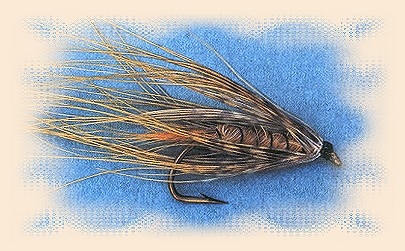Great Canadian Flies
Carey Special
By Arthur James Lingren

One of the patterns that is a staple in many a British Columbia angler's fly
box is the Carey Special. Colonel Carey's Special is listed as a "fancy" fly in
Roderick-Haig Brown's classic 1939 book, The Western Angler. He says:
This is far from being a complete list of the "fancy" flies . . .it includes at least
one fly which, besides being one of the best killers, is as somberly dressed
as any natural - Col. Carey's Special. Whether or not it was originally tied
as an imitation of some natural insect I do not know, but it has an extremely
lifelike action in the water and may well be taken for an imitation of a dragon-fly
nymph. (Vol1, p.103)
A sample Carey Special is shown in the frontispiece of Haig-Brown's 1939
classic. The Carey Special's origins, however dated back to the 1920s.
Colonel Carey, a retired British soldier, moved from Victoria to the Okanagan
in 1925, and, according to Martin Tolley, the development of a sure-fire
trout pattern became an obsession.
When you read the words written by Tolley in his "Colonel Carey" article
in the October, 1968 issue of Northwest Sportsman magazine,
a picture is framed in your mind of this old soldier in the wilds of British
Columbia dressing flies:
As a prelude to find the great solution his passion must have overcome the
old soldier because he failed to return from one of his spring offensives.
Quite naturally, the family became concerned for his safety and search
parties were dispatched to reconnoiter and bring him home. According
to the legend, the Colonel was wrestling with the issue at Arthur Lake
when discovered. He was sitting in his tent experimenting with prototypes
for his perfect fly, surrounded by corpses of cock pheasants. He had
literally clubbed dozens to death and not let a closed season stay his
quest for the prime rump feathers which he deemed the answer to
his enigma.
The Colonel produced a number of patterns, but the Carey Special proved
the Colonel's most successful. Now it is used all over the province and
elsewhere in sizes 2 to 12 in a variety of body colours: green, yellow, olive,
black and red. Tommy Brayshaw, who met Carey one 1934 day while
fishing Lac Le Jeune, affirms Carey developed the fly "when he was camped
at Arthur Lake and I think dressed it for a dragonfly nymph, at any rate we
did the same at Knouff with the 'pazooka' and fished it the same way."
(Tommy Brayshaw, The Ardent Angler-Artist, page 85.)
Brayshaw thought, but was not sure, that the sample Carey gave him at Le
Jeune consisted of a tail, body and wing of marmot . . . Fur and says Carey's
fly was referred to as The Dredge or Monkey Faced Louise. According to
Mr. Haywood of Harkley & Haywood, the Dredge was the popular Lower
Mainland name for Carey's fly. Brayshaw dressed his Carey with a deer-hair
body and ribbed it with black linen thread to protect the fragile hair body.
According to the history of the fly published in Steve Raymond's book
Kamloops (1971), the Carey Special, tied on a number
6 hook, was intended to represent a hatching sedge pupa. Whatever the
fish take the fly for, it is a very effective pattern, either cast and retrieved,
or trolled.
In the spring of 1982 a life-long friend invited me to his 250 acre, interior ranch
to fish his small but productive lake. I remember the day well. Large fish were
shrimping in the shallows, and I decided to try entice them with a Carey Special.
My two largest fish for the weekend were 5 and 6 pounds.
The fly, dressed in its many sizes and variations, is one of British Columbia's
most productive patterns.
Details
Hook: Number 6.
Tail: A few fibres from a ringed-neck
pheasant's rump feather.
Body: Ringed-neck pheasant tail fibers,
deer hair or marmot fur.
Rib: Black linen thread.
Collar: Ring-necked pheasant rump
feathers extending well past hook bend.
Originator: Colonel Carey.
Intended Use: Wet fly for rainbow trout.
Location: Arthur Lake, B.C. Canada.
~ Arthur James Lingren
Credits: From Fly Patterns of British Columbia
by Arthur James Lingren. We thank
Frank Amato Publications, Inc. for use permission!
Our Man In Canada Archives
|

